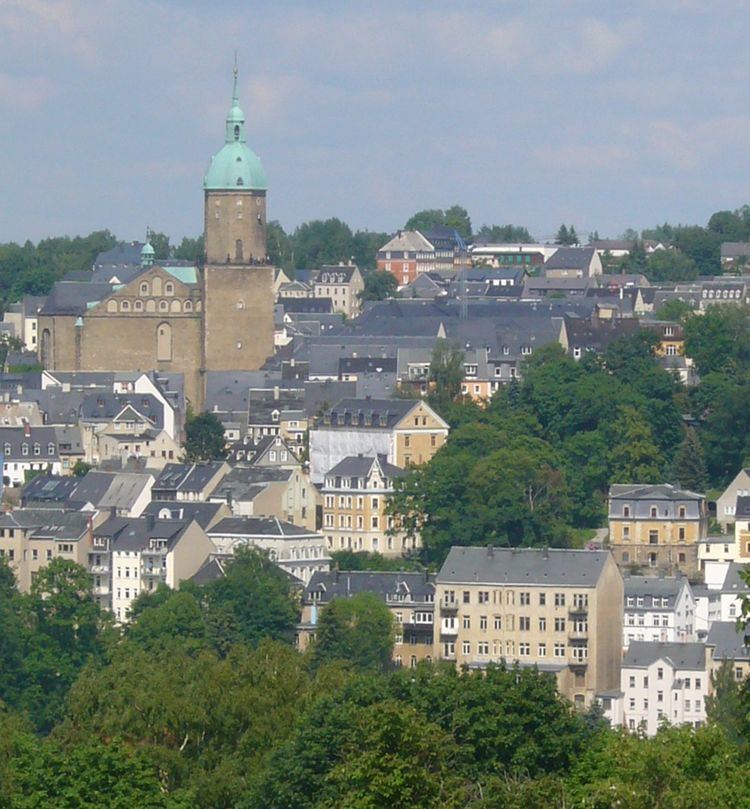Postal codes 09456 Population 22,248 (31 Dec 2008) | Time zone CET/CEST (UTC+1/+2) Dialling codes 03733 Local time Saturday 10:13 PM | |
 | ||
Weather 3°C, Wind SW at 23 km/h, 59% Humidity Points of interest St Anne's Church - Annaberg‑Buchholz, Manufaktur der Träume, Pöhlberg, Besucherbergwerk Markus Röhling S, Ore Mountain Museum | ||
Annaberg-Buchholz ( [ˈanabɛɐ̯k ˈbuːx.hɔlts]) is a town in the Free State of Saxony, Germany. Lying in the Ore Mountains, it is the capital of the district of Erzgebirgskreis.
Contents
- Map of Annaberg Buchholz Germany
- Annaberg buchholz von a z anders imagefilm
- Geography
- History
- Historical Population
- Main sights
- Museums
- Frohnauer Hammer
- Regular events
- International relations
- Sons and daughters of the town
- References
Map of Annaberg-Buchholz, Germany
Annaberg buchholz von a z anders imagefilm
Geography
The town is located in the Ore Mountains, at the side of the Pöhlberg (832 meters or 2,730 feet above sea level).
History
The previously heavily forested upper Ore Mountains were settled in the 12th and 13th centuries by Franconian farmers. Frohnau, Geyersdorf, and Kleinrückerswalde—all now part of present-day town—are all attested from 1397.
Barbara Uthmann introduced braid- and lace-making in 1561 and it was further developed in the 1590s by Belgian refugees fleeing the policies of Fernando Álvarez de Toledo, 3rd Duke of Alba, Spain's governor over the Low Countries. The industry was further developed in the 19th century, when Annaberg and Buchholz were connected by rail to Chemnitz and each other and both settlements had specialized schools for lace-making. The population of Annaberg in the 1870s was 11,693. This had risen to 16,811 by 1905, with another 9307 in Buchholz.
The town's mines formerly produced silver, tin, and cobalt but ceased production before the First World War. After the Reunification of Germany in 1989, some were restored for tourist purposes.
In 1945 the two towns Annaberg and Buchholz merged into the new town Annaberg-Buchholz.
Historical Population
At the start of the 16th Century Annaberg was one of the largest towns in Germany with an estimated 8,000 inhabitants. In 1834 Annaberg had a population of 5,068 and Buchholz 1,424. In 1875 people lived in Annaberg, in 1890 11,725, in 1925 18,204, and in 1933 19,818. The figures in the table are for Annaberg-Buchholz.
Historical population (from 1960, on 31st December):
Before 1945: Sum of population of towns Annaberg and BuchholzData source 1998: Statistical Office of Saxony
1 29 October
2 31 August
Main sights
The area is a tourist destination and ski resort. The Ore Mountains are referred to as Land of Christmas and famous for the Christmas Markets and the carved sculptures. Annaberg has a Roman Catholic church and three Protestant churches, among them St. Anne's (built 1499-1525), which is the largest of its kind in Saxony. There are public monuments to Luther, the famous mathematician Adam Ries, and Barbara Uthmann. Buchholz had another Gothic Protestant church and monuments to Frederick the Wise and Bismarck. Annaberg is well known for its historical old town and market square; the house Markt 2 shows the coat of arms of the family Apian-Bennewitz.
Museums
Frohnauer Hammer
The Frohnauer Hammer is a historic and fully working preserved hammer mill in the village of Frohnau within the municipality. In 1907, it was declared a technical monument and, since then, has been open to the public. In addition to the actual hammer mill itself, there is an exhibition of forged items and the former master hammersmith's house (Hammerherrenhaus).
Regular events
International relations
Annaberg-Buchholz is twinned with:
